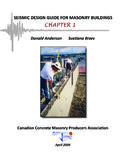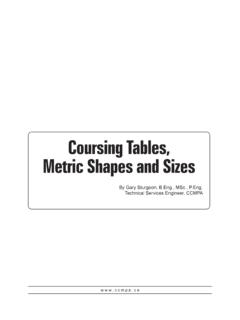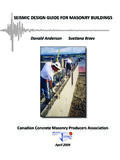Transcription of CAER - CCMPA
1 SEISMIC DESIGN GUIDE FOR MASONRY BUILDINGS Canadian Concrete Masonry Producers AssociationDonald Anderson Svetlana BrzevApril 2009 CHAPTER 4 DISCLAIMER While the authors have tried to be as accurate as possible, they cannot be held responsible for the designs of others that might be based on the material presented in this document. The material included in this document is intended for the use of design professionals who are competent to evaluate the significance and limitations of its contents and recommendations and able to accept responsibility for its application. The authors, and the Canadian Concrete Masonry Producers Association, disclaim any and all responsibility for the applications of the stated principles and for the accuracy of any of the material included in the document.
2 AUTHORS Don Anderson, , Department of Civil Engineering, University of British Columbia Vancouver, BC Svetlana Brzev, , Department of Civil Engineering British Columbia Institute of Technology Burnaby, BC TECHNICAL EDITORS Gary Sturgeon, , Director of Technical Services, CCMPA Bill McEwen, , LEED AP, Executive Director, Masonry Institute of BC Dr. Mark Hagel, EIT, Technical Services Engineer, CCMPA GRAPHIC DESIGN Natalia Leposavic, COVER PAGE Photo credit: Bill McEwen, Graphic design: Marjorie Greene, AICP COPYRIGHT Canadian Concrete Masonry Producers Association, 2009 Canadian Concrete Masonry Producers Association Box 54503, 1771 Avenue Road Toronto, ON M5M 4N5 Tel: (416) 495-7497 Fax: (416) 495-8939 Email: Web site: The Canadian Concrete Masonry Producers Association ( CCMPA ) is a non-profit association whose mission is to support and advance the common interests of its members in the manufacture, marketing, research, and application of concrete masonry products and structures.
3 It represents the interests of Region 6 of the National Concrete Masonry Association (NCMA). iContents Summary Chapter 1 NBCC 2005 Seismic Provisions Objective: to provide background on seismic response of structures and seismic analysis methods and explain key NBCC 2005 seismic provisions of relevance for masonry designDETAILED NBCC SEISMIC PROVISIONSC hapter 2 Seismic Design of Masonry Walls to CSA Objective: to provide background and commentary for CSA seismic design provisions related to reinforced concrete masonry walls, and discuss the revisions in CSA seismic design requirements with regard to the 1994 edition DETAILED MASONRY DESIGNPROVISIONSC hapter 3 Summary of Changes in NBCC 2005 and CSA Seismic Design Requirements for Masonry Buildings Objective.
4 To provide a summary of NBCC 2005 and CSA changes with regard to previous editions (NBCC 1995 and CSA ) and to present the results of a design case study of a hypothetical low-rise masonry building to illustrate differences in seismic forces and masonry design requirements due to different site locations and different editions of NBCC and CSA SUMMARY OF NBCC AND Chapter 4 Design Examples Objective: to provide illustrative design examples of seismic load calculation and distribution of forces to members according to NBCC 2005, and the seismic design of loadbearing and nonloadbearing masonry elements according to CSA DESIGNEXAMPLESA ppendix A Comparison of NBCC 1995 and NBCC 2005 Seismic Provisions Appendix BResearch Studies and Code Background Relevant to Masonry Design Appendix CRelevant Design Background Appendix DDesign Aids Appendix E Notation4/1/2009 4-1 TABLE OF CONTENTS CHAPTER 4 4 DESIGN EXAMPLES 1 Seismic load calculation for a low-rise masonry building to NBCC 2005 4-2 2 Seismic load calculation for a medium-rise masonry building to NBCC 2005 4-8 3 Seismic load distribution in a masonry building considering both rigid and flexible diaphragm alternatives 4-22 4a
5 Minimum seismic reinforcement for a squat masonry shear wall 4-34 4b Seismic design of a squat shear wall of conventional construction 4-41 4c Seismic design of a squat shear wall of moderate ductility 4-47 5a Seismic design of a flexural shear wall of limited ductility 4-57 5b Seismic design of a flexural shear wall of moderate ductility 4-66 6a Design of a loadbearing wall for out-of-plane seismic effects 4-75 6b Design of a nonloadbearing wall for out-of-plane seismic effects 4-82 7 Seismic design of masonry veneer ties 4-87 8 Seismic design of a masonry infill wall 4-89 4/1/2009 4-2 4 Design Examples EXAMPLE 1: Seismic load calculation for a low-rise masonry building to NBCC 2005 Consider a single-storey warehouse building located in Mississauga, Ontario.
6 The building plan dimensions are 64 m length by 27 m width, as shown on the figure below. The roof structure consists of steel beams, open web steel joists, and a composite steel and concrete deck with 70 mm concrete topping. The roof is supported by 190 mm reinforced block masonry walls at the perimeter and interior steel columns. The roof elevation is m above the foundation. The soil at the building site is classed as a Site Class D per NBCC 2005. Calculate the seismic base shear force for this building to NBCC 2005 seismic requirements (considering the masonry walls to be detailed as conventional construction ). Next, determine the seismic shear forces in the walls, including the effect of accidental torsional eccentricity.
7 Assume that the roof acts like a rigid diaphragm. 4/1/2009 4-3 SOLUTION: 1. Calculate the seismic weight W (NBCC 2005 ) a) Roof loads: - Snow load (Mississauga, ON) sW = *( * + )= kPa (25% of the total snow load is used for the seismic weight) - Roof self-weight (including beams, trusses, steel deck, roofing, insulation, and 65 mm concrete topping) DW = kPa Total roof seismic weight roofW= ( + )( * )= 5046 kN b) Wall weight: Assume solid grouted walls w= kN/m2 (this is a conservative assumption and could be changed later if it is determined that partially grouted walls would be adequate) The usual assumption is that the weight of all the walls above wall midheight is part of the seismic weight (mass) that responds to the ground motion and contributes to the total base shear.
8 Tributary wall surface area: - North face elevation = *7* * + (64m-7*3m)*( )= m2 - South face elevation (same as north face elevation) = m2 - East face elevation = *2* * + (27m-2*8m)*( ) = m2 - West face elevation (same as east face elevation) = m2 Total tributary wall area Area = m2 _____ Total wall seismic weight AreawWwall*== * 2100 kN The total seismic weight is equal to the sum of roof weight and the wall weight, that is, wallroofWWW+== 5046+2100= 7146 kN 7150 kN 2. Determine the seismic hazard for the site (see Section ).
9 Location: Mississauga, ON ) (aS= (NBCC 2005 Appendix C, page C-21) ) (aS= ) (aS= ) (aS= Foundation factors aF= for ) (aS= and Site Class D (by interpolation from Table 1-10 or NBCC 2005 Table , since aF= for ) (aS andaF= for =) (aS vF= for ) (aS= and Site Class D (from Table 1-11 or NBCC 2005 Table ), since vF= for ) (aS Site design spectrum ()TS (see Section ) For T= sec: () () * () For T= sec: use the smaller of; () () * or 4/1/2009 4-4 () () * , thus () For T=1 sec: () () * () For T=2 sec: () () * () The site design spectrum ()TS is shown below.)
10 Building period (T) calculation (see Section and NBCC 2005 (3).c) for wall structures) nh= m building height () sec Then interpolate between () and () determine the design spectral acceleration: ()TS=() 3. Compute the seismic base shear (see Section ) The base shear is given by the expression (NBCC 2005 ) ()WRRIMTSVodEv= where EI= (building importance factor, equal to for normal importance, for high importance, and for post-disaster buildings) vM= (higher mode factor, equal to for sec, that is, most low-rise masonry buildings) Building SFRS description: masonry structure conventional construction (see Table 1-13 or NBCC 2005 Table ), hence dR= and oR= The design base shear V is given by: () * * * but not less than () * * * and need not be taken more than 4/1/2009 4-5() * * = =, provided dR.



